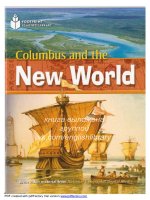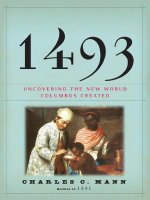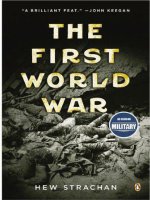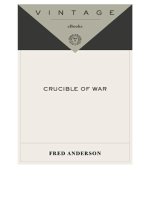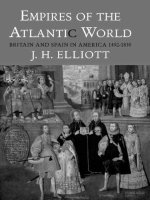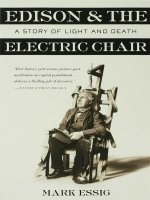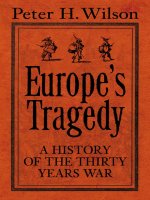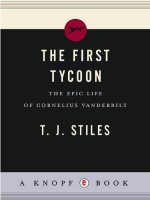Charles c mann 1493 uncovering the new world ted (v5 0)
Bạn đang xem bản rút gọn của tài liệu. Xem và tải ngay bản đầy đủ của tài liệu tại đây (19.25 MB, 567 trang )
Click here to view a larger image.
THIS IS A BORZOI BOOK
PUBLISHED BY ALFRED A. KNOPF
Copyright © 2011 by Charles C. Mann
All rights reserved. Published in the United States by Alfred A. Knopf, a division of Random House, Inc., New York, and in Canada by Random
House of Canada Limited, Toronto.
www.aaknopf.com
Knopf, Borzoi Books, and the colophon are registered trademarks of Random House, Inc.
The author gratefully acknowledges the support of the Lannan Foundation.
Portions of this book have appeared in different form in The Atlantic, National Geographic, Orion, and Science.
Maps created by Nick Springer and Tracy Pollock, Springer Cartographics LLC; copyright © by 2011 Charles C. Mann
Library of Congress Cataloging-in-Publication Data
Mann, Charles C.
1493 : uncovering the new world Columbus created / Charles C. Mann. —1st ed.
p. cm.
Includes bibliographical references and index.
eISBN: 978-0-307-59672-7
1. History, Modern. 2. Economic history. 3. Commerce—History. 4. Agriculture—History. 5. Ecology—History. 6. Industrial revolution. 7. Slave
trade—History. 8. America—Discovery and exploration—Economic aspects. 9. America—Discovery and exploration—Environmental aspects. 10.
Columbus, Christopher—Influence. I. Title.
D 228.M36 2011
909’.4—dc22
2011003408
Front-of-jacket image: De Español y Negra, Mulato, attributed to José de Alcibar, c. 1760. Denver Art Museum, Collection of Frederick and Jan
Mayer.
Photo © James O. Milmoe.
Jacket design by Abby Weintraub
v3.1
To the woman who built my house,
and is my home
—CCM
CONTENTS
Cover
Map
Title Page
Copyright
Dedication
List of Maps
Prologue
/ In the Homogenocene
INTRODUCTION
1. Two Monuments
PART ONE
2. The Tobacco Coast
/ Atlantic Journeys
3. Evil Air
PART TWO
/ Pacific Journeys
4. Shiploads of Money (Silk for Silver, Part One)
5. Lovesick Grass, Foreign Tubers, and Jade Rice (Silk for Silver, Part Two)
PART THREE
6. The Agro-Industrial Complex
/ Europe in the World
7. Black Gold
PART FOUR
8. Crazy Soup
/ Africa in the World
9. Forest of Fugitives
CODA
10. In Bulalacao
Appendixes
A. Fighting Words
B. Globalization in Beta
Acknowledgments
Notes
Works Cited
Index
About the Author
/ Currents of Life
Other Books by This Author
Additional Images
MAPS
Map
Map
Map
Map
Map
Map
Map
Map
Map
Map
Map
Map
Map
Map
Map
Map
Map
Map
1 The World, 1493
2 Colonial Hispaniola
3 China Sea, 1571
4 Deforestation and Reforestation in Eastern North America, 1500–1650
5 Tsenacomoco, 1607–1670
6 Malaria in Southeast England
7 American Anopheles
8 Recreating Pangaea, 1600
9 Fujian in the Ming Era
10 Viceroyalty of Peru
11 China in the Qing Era
12 China Floods, 1823
13 Spread of Potato Blight, 1845
14 Rubber World, c. 1890
15 Spread of Sugar Through the Mediterranean and Beyond
16 Estate of Hernán Cortés, 1547
17 Portuguese Expansion into Brazil
18 Maroon Landscapes
PROLOGUE
Like other books, this one began in a garden. Almost twenty years ago I came across a
newspaper notice about some local college students who had grown a hundred di erent
varieties of tomato. Visitors were welcome to take a look at their work. Because I like
tomatoes, I decided to drop by with my eight-year-old son. When we arrived at the
school greenhouse I was amazed—I’d never seen tomatoes in so many di erent sizes,
shapes, and colors.
A student o ered us samples on a plastic plate. Among them was an alarmingly lumpy
specimen, the color of an old brick, with a broad, green-black tonsure about the stem.
Occasionally I have dreams in which I experience a sensation so intensely that I wake
up. This tomato was like that—it jolted my mouth awake. Its name, the student said,
was Black from Tula. It was an “heirloom” tomato, developed in nineteenth-century
Ukraine.
“I thought tomatoes came from Mexico,” I said, surprised. “What are they doing
breeding them in Ukraine?”
The student gave me a catalog of heirloom seeds for tomatoes, chili peppers, and
beans (common beans, not green beans). After I went home, I ipped through the
pages. All three crops originated in the Americas. But time and again the varieties in the
catalog came from overseas: Japanese tomatoes, Italian peppers, Congolese beans.
Wanting to have more of those strange but tasty tomatoes, I went on to order seeds,
sprout them in plastic containers, and stick the seedlings in a garden, something I’d
never done before.
Not long after my trip to the greenhouse I visited the library. I discovered that my
question to the student had been o the mark. To begin, tomatoes probably originated
not in Mexico, but in the Andes Mountains. Half a dozen wild tomato species exist in
Peru and Ecuador, all but one inedible, producing fruit the size of a thumbtack. And to
botanists the real mystery is less how tomatoes ended up in Ukraine or Japan than how
the progenitors of today’s tomato journeyed from South America to Mexico, where
native plant breeders radically transformed the fruits, making them bigger, redder, and,
most important, more edible. Why transport useless wild tomatoes for thousands of
miles? Why had the species not been domesticated in its home range? How had people
in Mexico gone about changing the plant to their needs?
These questions touched on a long-standing interest of mine: the original inhabitants
of the Americas. As a reporter in the news division of the journal Science, I had from
time to time spoken with archaeologists, anthropologists, and geographers about their
increasing recognition of the size and sophistication of long-ago native societies. The
botanists’ puzzled respect for Indian plant breeders t nicely into that picture.
Eventually I learned enough from these conversations that I wrote a book about
researchers’ current views of the history of the Americas before Columbus. The tomatoes
in my garden carried a little of that history in their DNA.
They also carried some of the history after Columbus. Beginning in the sixteenth
century, Europeans carried tomatoes around the world. After convincing themselves that
the strange fruits were not poisonous, farmers planted them from Africa to Asia. In a
small way, the plant had a cultural impact everywhere it moved. Sometimes not so
small—one can scarcely imagine southern Italy without tomato sauce.
Still, I didn’t grasp that such biological transplants might have played a role beyond
the dinner plate until in a used-book store I came across a paperback: Ecological
Imperialism, by Alfred W. Crosby, a geographer and historian then at the University of
Texas. Wondering what the title could refer to, I picked up the book. The rst sentence
seemed to jump o the page: “European emigrants and their descendants are all over
the place, which requires explanation.”
I understood exactly what Crosby was getting at. Most Africans live in Africa, most
Asians in Asia, and most Native Americans in the Americas. People of European descent,
by contrast, are thick on the ground in Australia, the Americas, and southern Africa.
Successful transplants, they form the majority in many of those places—an obvious fact,
but one I had never really thought about before. Now I wondered: Why is that the case?
Ecologically speaking, it is just as much a puzzle as tomatoes in Ukraine.
Before Crosby (and some of his colleagues) looked into the matter, historians tended to
explain Europe’s spread across the globe almost entirely in terms of European
superiority, social or scienti c. Crosby proposed another explanation in Ecological
Imperialism. Europe frequently had better-trained troops and more-advanced weaponry
than its adversaries, he agreed, but in the long run its critical advantage was biological,
not technological. The ships that sailed across the Atlantic carried not only human
beings, but plants and animals—sometimes intentionally, sometimes accidentally. After
Columbus, ecosystems that had been separate for eons suddenly met and mixed in a
process Crosby called, as he had titled his previous book, the Columbian Exchange. The
exchange took corn (maize) to Africa and sweet potatoes to East Asia, horses and
apples, to the Americas, and rhubarb and eucalyptus to Europe—and also swapped
about a host of less-familiar organisms like insects, grasses, bacteria, and viruses. The
Columbian Exchange was neither fully controlled nor understood by its participants, but
it allowed Europeans to transform much of the Americas, Asia, and, to a lesser extent,
Africa into ecological versions of Europe, landscapes the foreigners could use more
comfortably than could their original inhabitants. This ecological imperialism, Crosby
argued, provided the British, French, Dutch, Portuguese, and Spanish with the consistent
edge needed to win their empires.
Crosby’s books were constitutive documents in a new discipline: environmental
history. The same period witnessed the rise of another discipline, Atlantic studies, which
stressed the importance of interactions among the cultures bordering that ocean.
(Recently a number of Atlanticists have added movements across the Paci c to their
purview; the eld may have to be renamed.) Taken together, researchers in all these
elds have been assembling what amounts to a new picture of the origins of our worldspanning, interconnected civilization, the way of life evoked by the term
“globalization.” One way to summarize their e orts might be to say that to the history
of kings and queens most of us learned as students has been added a recognition of the
remarkable role of exchange, both ecological and economic. Another way might be to
say that there is a growing recognition that Columbus’s voyage did not mark the
discovery of a New World, but its creation. How that world was created is the subject of
this book.
The research has been greatly aided by recently developed scienti c tools. Satellites
map out environmental changes wreaked by the huge, largely hidden trade in latex, the
main ingredient in natural rubber. Geneticists use DNA assays to trace the ruinous path
of potato blight. Ecologists employ mathematical simulations to simulate the spread of
malaria in Europe. And so on—the examples are legion. Political changes, too, have
helped. To cite one of special importance to this book, it is much easier to work in China
nowadays than it was in the early 1980s, when Crosby was researching Ecological
Imperialism. Today, bureaucratic suspicion is minimal; the chief obstacle I faced during
my visits to Beijing was the abominable tra c. Librarians and researchers there happily
gave me early Chinese records—digital scans of the originals, which they let me copy
onto a little memory stick that I carried in my shirt pocket.
What happened after Columbus, this new research says, was nothing less than the
forming of a single new world from the collision of two old worlds—three, if one counts
Africa as separate from Eurasia. Born in the sixteenth century from European desires to
join the thriving Asian trade sphere, the economic system for exchange ended up
transforming the globe into a single ecological system by the nineteenth century—
almost instantly, in biological terms. The creation of this ecological system helped
Europe seize, for several vital centuries, the political initiative, which in turn shaped the
contours of today’s world-spanning economic system, in its interlaced, omnipresent,
barely comprehended splendor.
Ever since violent protests at a 1999 World Trade Organization meeting in Seattle
brought the idea of globalization to the world’s attention, pundits of every ideological
stripe have barraged the public with articles, books, white papers, blog posts, and video
documentaries attempting to explain, celebrate, or attack it. From the start the debate
has focused around two poles. On one side are economists and entrepreneurs who argue
passionately that free trade makes societies better o —that both sides of an uncoerced
exchange gain from it. The more trade the better! they say. Anything less amounts to
depriving people in one place of the fruits of human ingenuity in other places. On the
other side is a din of environmental activists, cultural nationalists, labor organizers, and
anti-corporate agitators who charge that unregulated trade upends political, social, and
environmental arrangements in ways that are rarely anticipated and usually
destructive. The less trade, they say, the better. Protect local communities from the
forces unleashed by multinational greed!
Whipsawed between these two opposing views, the global network has become the
subject of a furious intellectual battle, complete with mutually contradictory charts,
graphs, and statistics—and tear gas and ying bricks in the streets where political
leaders meet behind walls of riot police to wrangle through international-trade
agreements. Sometimes the moil of slogans and counter-slogans, facts and factoids,
seems impenetrable, but as I learned more I came to suspect that both sides may be
correct. From the outset globalization brought both enormous economic gains and
ecological and social tumult that threatened to offset those gains.
It is true that our times are di erent from the past. Our ancestors did not have the
Internet, air travel, genetically modi ed crops, or computerized international stock
exchanges. Still, reading the accounts of the creation of the world market one cannot
help hearing echoes—some muted, some thunderously loud—of the disputes now on the
television news. Events four centuries ago set a template for events we are living
through today.
·
·
·
What this book is not: a systematic exposition of the economic and ecological roots of
what some historians call, ponderously but accurately, “the world-system.” Some parts
of the earth I skip entirely; some important events I barely mention. My excuse is that
the subject is too big for any single work; indeed, even a pretense at completeness
would be unwieldy and unreadable. Nor do I fully treat how researchers came to form
this new picture, though I describe some of the main landmarks along the intellectual
way. Instead in 1493 I concentrate on areas that seem to me to be especially important,
especially well documented, or—here showing my journalist’s bias—especially
interesting. Readers wishing to learn more can turn to the sources in the Notes and
Bibliography.
Following an introductory chapter, the book is divided into four sections. The rst two
lay out, so to speak, the constituent halves of the Columbian Exchange: the separate but
linked exchanges across the Atlantic and Paci c. The Atlantic section begins with the
exemplary case of Jamestown, the beginning of permanent English colonization in the
Americas. Established as a purely economic venture, its fate was largely decided by
ecological forces, notably the introduction of tobacco. Originally from the lower
Amazon, this exotic species—exciting, habit-forming, vaguely louche—became the
subject of the rst truly global commodity craze. (Silk and porcelain, long a passion in
Europe and Asia, spread to the Americas and became the next ones.) The chapter sets
the groundwork for the next, which discusses the introduced species that shaped, more
than any others, societies from Baltimore to Buenos Aires: the microscopic creatures that
cause malaria and yellow fever. After examining their impact on matters ranging from
slavery in Virginia to poverty in the Guyanas, I close with malaria’s role in the creation
of the United States.
The second section shifts the focus to the Paci c, where the era of globalization began
with vast shipments of silver from Spanish America to China. It opens with a chronicle
of cities: Potosí in what is now Bolivia, Manila in the Philippines, Yuegang in southeast
China. Once renowned, now little thought of, these cities were the fervid, essential links
in an economic exchange that knit the world together. Along the way, the exchange
brought sweet potatoes and corn to China, which had accidental, devastating
consequences for Chinese ecosystems. As in a classic feedback loop, those ecological
consequences shaped subsequent economic and political conditions. Ultimately, sweet
potatoes and corn played a major part in the owering and collapse of the last Chinese
dynasty. They played a small, but similarly ambiguous role in the Communist dynasty
that eventually succeeded it.
The third section shows the role of the Columbian Exchange in two revolutions: the
Agricultural Revolution, which began in the late seventeenth century; and the Industrial
Revolution, which took o in the early and mid-nineteenth century. I concentrate on
two introduced species: the potato (taken from the Andes to Europe) and the rubber tree
(transplanted clandestinely from Brazil to South and Southeast Asia). Both revolutions,
agricultural and industrial, supported the rise of the West—its sudden emergence as a
controlling power. And both would have had radically di erent courses without the
Columbian Exchange.
In the fourth section I pick up a theme from the rst section. Here I turn to what in
human terms was the most consequential exchange of all: the slave trade. Until around
1700 about 90 percent of the people who crossed the Atlantic were African captives.
(Native Americans made up part of the remainder, as I explain.) In consequence of this
great shift in human populations, many American landscapes were for three centuries
largely dominated, in demographic terms, by Africans, Indians, and Afro-Indians. Their
interactions, long hidden from Europeans, are an important part of our human heritage
that is just coming to light.
The meeting of red and black, so to speak, took place against a backdrop of other
meetings. So many di erent peoples were involved in the spasms of migration set o by
Columbus that the world saw the rise of the rst of the now-familiar polyglot, worldencompassing metropolises: Mexico City. Its cultural jumble extended from the top of
the social ladder, where the conquistadors married into the nobility of the peoples they
had conquered, to the bottom, where Spanish barbers complained bitterly about lowpaid immigrant barbers from China. A planetary crossroads, this great, turbulent
metropolis represents the uni cation of the two networks described in the rst part of
this book. A coda set in the present suggests that these exchanges continue unabated.
In some respects this image of the past—a cosmopolitan place, driven by ecology and
economics—is startling to people who, like me, were brought up on accounts of heroic
navigators, brilliant inventors, and empires acquired by dint of technological and
institutional superiority. It is strange, too, to realize that globalization has been
enriching the world for nigh on ve centuries. And it is unsettling to think of
globalization’s equally long record of ecological convulsion, and the su ering and
political mayhem caused by that convulsion. But there is grandeur, too, in this view of
our past; it reminds us that every place has played a part in the human story, and that
all are embedded in the larger, inconceivably complex progress of life on this planet.
·
·
·
As I write these words, it’s a warm August day. Yesterday my family picked the rst
tomatoes from our garden—the somewhat improved successor of the tomato patch I
planted after my visit to the college twenty years ago.
After I planted the seeds from the catalog, it didn’t take me long to discover why so
many people love puttering in their gardens. Messing around with the tomatoes felt to
me like building a fort as a child: I was both creating a refuge from the world and
creating a place of my own in that world. Kneeling in the dirt, I was making a small
landscape, one that had the comfortable, comforting timelessness evoked by words like
home.
To biologists this must seem like poppycock. At various times my tomato patch has
housed basil, eggplant, bell peppers, kale, chard, several types of lettuce and lettuce-like
greens, and a few marigolds, said by my neighbors to repel bugs (scientists are less
certain). Not one of these species originated within a thousand miles of my garden. Nor
did the corn and tobacco grown in nearby farms; corn is from Mexico, tobacco from the
Amazon (this species of tobacco, anyway—there was a local species that is now gone).
Equally alien, for that matter, are my neighbors’ cows, horses, and barn cats. That
people like me experience their gardens as familiar and timeless is a testament to the
human capacity to adapt (or, less charitably, to our ability to operate in ignorance).
Rather than being a locus of stability and tradition, my garden is a biological record of
past human wandering and exchange.
Yet in another way my feelings are correct. Almost seventy years ago the Cuban
folklorist Fernando Ortiz Fernández coined the awkward but useful term
“transculturation” to describe what happens when one group of people takes something
—a song, a food, an ideal—from another. Almost inevitably, Ortiz noted, the new thing
is transformed; people make it their own by adapting, stripping, and twisting it to t
their needs and situation. Since Columbus the world has been in the grip of convulsive
transculturation. Every place on the earth’s surface, save possibly scraps of Antarctica,
has been changed by places that until 1492 were too remote to exert any impact on it.
For ve centuries now the crash and chaos of constant connection has been our home
condition; my garden, with its parade of exotic plants, is a small example. How did
those tomatoes get to Ukraine, anyway? One way to describe this book would be to say
that it represents, long after I first asked the question, my best efforts to find out.
INTRODUCTION
In the Homogenocene
1
Two Monuments
THE SEAMS OF PANGAEA
Although it had just nished raining, the air was hot and close. Nobody else was in
sight; the only sound other than those from insects and gulls was the staticky low
crashing of Caribbean waves. Around me on the sparsely covered red soil was a scatter
of rectangles laid out by lines of stones: the outlines of now-vanished buildings, revealed
by archaeologists. Cement pathways, steaming faintly from the rain, ran between them.
One of the buildings had more imposing walls than the others. The researchers had
covered it with a new roof, the only structure they had chosen to protect from the rain.
Standing like a sentry by its entrance was a hand-lettered sign: Casa Almirante,
Admiral’s House. It marked the rst American residence of Christopher Columbus,
Admiral of the Ocean Sea, the man whom generations of schoolchildren have learned to
call the discoverer of the New World.
La Isabela, as this community was called, is situated on the north side of the great
Caribbean island of Hispaniola, in what is now the Dominican Republic. It was the
initial attempt by Europeans to make a permanent base in the Americas. (To be precise,
La Isabela marked the beginning of consequential European settlement—Vikings had
established a short-lived village in Newfoundland ve centuries before.) The admiral
laid out his new domain at the con uence of two small, fast-rushing rivers: a forti ed
center on the north bank, a satellite community of farms on the south bank. For his
home, Columbus—Cristóbal Colón, to give him the name he answered to at the time—
chose the best location in town: a rocky promontory in the northern settlement, right at
the water’s edge. His house was situated perfectly to catch the afternoon light.
Today La Isabela is almost forgotten. Sometimes a similar fate appears to threaten its
founder. Colón is by no means absent from history textbooks, of course, but in them he
seems ever less admirable and important. He was a cruel, deluded man, today’s critics
say, who stumbled upon the Caribbean by luck. An agent of imperialism, he was in
every way a calamity for the Americas’ rst inhabitants. Yet a di erent but equally
contemporary perspective suggests that we should continue to take notice of the
admiral. Of all the members of humankind who have ever walked the earth, he alone
inaugurated a new era in the history of life.
Lines of stones mark the outlines of now-vanished buildings at La Isabela, Christopher Columbus’s first attempt to establish a permanent base in
the Americas. (Photo credit 1.1)
The king and queen of Spain, Fernando (Ferdinand) II and Isabel I, backed Colón’s
rst voyage grudgingly. Transoceanic travel in those days was heart-stoppingly
expensive and risky—the equivalent, perhaps, of space-shuttle ights today. Despite
relentless pestering, Colón was able to talk the monarchs into supporting his scheme
only by threatening to take the project to France. He was riding to the frontier, a friend
wrote later, when the queen “sent a court baili posthaste” to fetch him back. The story
is probably exaggerated. Still, it is clear that the sovereigns’ reservations drove the
admiral to whittle down his expedition, if not his ambitions, to a minimum: three small
ships (the biggest may have been less than sixty feet long), a combined crew of about
ninety. Colón himself had to contribute a quarter of the budget, according to a
collaborator, probably by borrowing it from Italian merchants.
Everything changed with his triumphant return in March of 1493, bearing golden
ornaments, brilliantly colored parrots, and as many as ten captive Indians. The king
and queen, now enthusiastic, dispatched Colón just six months later on a second, vastly
larger expedition: seventeen ships, a combined crew of perhaps fteen hundred, among
them a dozen or more priests charged with bringing the faith to these new lands.
Because the admiral believed he had found a route to Asia, he was sure that China and
Japan—and all their opulent goods—were only a short journey beyond. The goal of this
second expedition was to create a permanent bastion for Spain in the heart of Asia, a
headquarters for further exploration and trade.
The new colony, predicted one of its founders, “will be widely renowned for its many
inhabitants, its elaborate buildings, and its magni cent walls.” Instead La Isabela was a
catastrophe, abandoned barely ve years after its creation. Over time its structures
vanished, their very stones stripped to build other, more successful towns. When a U.S.–
Venezuelan archaeological team began excavating the site in the late 1980s, the
inhabitants of La Isabela were so few that the scientists were able to move the entire
settlement to a nearby hillside. Today it has a couple of roadside sh restaurants, a
single, failing hotel, and a little-visited museum. On the edge of town, a church, built in
1994 but already showing signs of age, commemorates the rst Catholic Mass celebrated
in the Americas. Watching the waves from the admiral’s ruined home, I could easily
imagine disappointed tourists thinking that the colony had left nothing meaningful
behind—that there was no reason, aside from the pretty beach, for anyone to pay
attention to La Isabela. But that would be a mistake.
Babies born on the day the admiral founded La Isabela—January 2, 1494—came into
a world in which direct trade and communication between western Europe and East
Asia were largely blocked by the Islamic nations between (and their partners in Venice
and Genoa), sub-Saharan Africa had little contact with Europe and next to none with
South and East Asia, and the Eastern and Western hemispheres were almost entirely
ignorant of each other’s very existence. By the time those babies had grandchildren,
slaves from Africa mined silver in the Americas for sale to China; Spanish merchants
waited impatiently for the latest shipments of Asian silk and porcelain from Mexico; and
Dutch sailors traded cowry shells from the Maldive Islands, in the Indian Ocean, for
human beings in Angola, on the coast of the Atlantic. Tobacco from the Caribbean
ensorcelled the wealthy and powerful in Madrid, Madras, Mecca, and Manila. Group
smoke-ins by violent young men in Edo (Tokyo) would soon lead to the formation of
two rival gangs, the Bramble Club and the Leather-breeches Club. The shogun jailed
seventy of their members, then banned smoking.
Long-distance trade had occurred for more than a thousand years, much of it across the
Indian Ocean. China had for centuries sent silk to the Mediterranean by the Silk Road, a
route that was lengthy, dangerous, and, for those who survived, hugely pro table. But
nothing like this worldwide exchange had existed before, still less sprung up so quickly,
or functioned so continuously. No previous trade networks included both of the globe’s
two hemispheres; nor had they operated on a scale large enough to disrupt societies on
opposite sides of the planet. By founding La Isabela, Colón initiated permanent
European occupation in the Americas. And in so doing he began the era of
globalization—the single, turbulent exchange of goods and services that today engulfs the
entire habitable world.
Newspapers usually describe globalization in purely economic terms, but it is also a
biological phenomenon; indeed, from a long-term perspective it may be primarily a
biological phenomenon. Two hundred and fty million years ago the world contained a
single landmass known to scientists as Pangaea. Geological forces broke up this vast
expanse, splitting Eurasia and the Americas. Over time the two divided halves of
Pangaea developed wildly di erent suites of plants and animals. Before Colón a few
venturesome land creatures had crossed the oceans and established themselves on the
other side. Most were insects and birds, as one would expect, but the list also includes,
surprisingly, a few farm species—bottle gourds, coconuts, sweet potatoes—the subject
today of scholarly head-scratching. Otherwise, the world was sliced into separate
ecological domains. Colón’s signal accomplishment was, in the phrase of historian
Alfred W. Crosby, to reknit the seams of Pangaea. After 1492 the world’s ecosystems
collided and mixed as European vessels carried thousands of species to new homes
across the oceans. The Columbian Exchange, as Crosby called it, is the reason there are
tomatoes in Italy, oranges in the United States, chocolates in Switzerland, and chili
peppers in Thailand. To ecologists, the Columbian Exchange is arguably the most
important event since the death of the dinosaurs.
Unsurprisingly, this vast biological upheaval had repercussions on humankind. Crosby
argued that the Columbian Exchange underlies much of the history we learn in the
classroom—it was like an invisible wave, sweeping along kings and queens, peasants
and priests, all unknowing. The claim was controversial; indeed, Crosby’s manuscript,
rejected by every major academic publisher, ended up being published by such a tiny
press that he once joked to me that his book had been distributed “by tossing it on the
street, and hoping readers happened on it.” But over the decades since he coined the
term, a growing number of researchers have come to believe that the ecological
paroxysm set o by Colón’s voyages—as much as the economic convulsion he began—
was one of the establishing events of the modern world.
On Christmas Day, 1492, Colón’s rst voyage came to an abrupt end when his
agship, the Santa María, ran aground o the northern coast of Hispaniola. Because his
two remaining vessels, the Niña and Pinta, were too small to hold the entire crew, he
was forced to leave thirty-eight men behind. Colón departed for Spain while those men
were building an encampment—a scatter of makeshift huts surrounded by a crude
palisade, adjacent to a larger native village. The encampment was called La Navidad
(Christmas), after the day of its involuntary creation (its precise location is not known
today). Hispaniola’s native people have come to be known as the Taino. The conjoined
Spanish-Taino settlement of La Navidad was the intended destination of Colón’s second
voyage. He arrived there in triumph, the head of a otilla, his crewmen swarming the
shrouds in their eagerness to see the new land, on November 28, 1493, eleven months
after he had left his men behind.
He found only ruin; both settlements, Spanish and Taino, had been razed. “We saw
everything burned and the clothing of Christians lying on the weeds,” the ship’s doctor
wrote. Nearby Taino showed the visitors the bodies of eleven Spaniards, “covered by the
vegetation that had grown over them.” The Indians said that the sailors had angered
their neighbors by raping some women and murdering some men. In the midst of the
con ict a second Taino group had swooped down and overwhelmed both sides. After
nine days of fruitless search for survivors Colón left to nd a more promising spot for
his base. Struggling against contrary winds, the eet took almost a month to crawl a
hundred miles east along the coast. On January 2, 1494, Colón arrived at the shallow
bay where he would found La Isabela.
Click here to view a larger image.
Almost immediately the colonists ran short of food and, worse, water. In a sign of his
inadequacy as an administrator, the admiral had failed to inspect the water casks he had
ordered; they, predictably, leaked. Ignoring all complaints of hunger and thirst, the
admiral decreed that his men would clear and plant vegetable patches, erect a two-story
fortress, and enclose the main, northern half of the new enclave within high stone walls.
Inside the walls the Spaniards built perhaps two hundred houses, “small like the huts we
use for bird hunting and roofed with weeds,” one man complained.1
Most of the new arrivals viewed these labors as a waste of time. Few actually wanted
to set up shop in La Isabela, still less till its soil. Instead they regarded the colony as a
temporary base camp for the quest for riches, especially gold. Colón himself was
ambivalent. On the one hand, he was supposed to be governing a colony that was
establishing a commercial entrepôt in the Americas. On the other hand, he was supposed
to be at sea, continuing his search for China. The two roles con icted, and Colón was
never able to resolve the conflict.
On April 24 Colón sailed o to nd China. Before leaving, he ordered his military
commander, Pedro Margarit, to lead four hundred men into the rugged interior to seek
Indian gold mines. After nding only trivial quantities of gold—and not much food—in
the mountains, Margarit’s charges, tattered and starving, came back to La Isabela, only
to discover that the colony, too, had little to eat—those left behind, resentful, had
refused to tend gardens. The irate Margarit hijacked three ships and ed to Spain,
promising to brand the entire enterprise as a waste of time and money. Left behind with
no food, the remaining colonists took to raiding Taino storehouses. Infuriated, the
Indians struck back, setting o a chaotic war. This was the situation that confronted
Colón when he returned to La Isabela ve months after his departure, dreadfully sick
and having failed to reach China.
A loose alliance of four Taino groups faced o against the Spaniards and one Taino
group that had thrown its lot in with the foreigners. The Taino, who had no metal, could
not withstand assaults with steel weapons. But they made the ght costly for the
Spaniards. In an early form of chemical warfare, the Indians threw gourds stu ed with
ashes and ground hot peppers at their attackers, unleashing clouds of choking, blinding
smoke. Protective bandannas over their faces, they charged through the tear gas, killing
Spaniards. The intent was to push out the foreigners—an unthinkable course to Colón,
who had staked everything on the voyage. When the Spaniards counterattacked, the
Taino retreated scorched-earth style, destroying their own homes and gardens in the
belief, Colón wrote scornfully, “that hunger would drive us from the land.” Neither side
could win. The Taino alliance could not eject the Spaniards from Hispaniola. But the
Spaniards were waging war on the people who provided their food supply; total victory
would be a total disaster. They won skirmish after skirmish, killing countless natives.
Meanwhile, starvation, sickness, and exhaustion filled the cemetery in La Isabela.
Humiliated by the calamity, the admiral set o for Spain on March 10, 1496, to beg
the king and queen for more money and supplies. When he returned two years later—
the third of what would become four voyages across the Atlantic—so little was left of La
Isabela that he landed on the opposite side of the island, in Santo Domingo, a new
settlement founded by his brother Bartolomé, whom he had left behind. Colón never
again set foot in his first colony and it was almost forgotten.
Despite the brevity of its existence, La Isabela marked the beginning of an enormous
change: the creation of the modern Caribbean landscape. Colón and his crew did not
voyage alone. They were accompanied by a menagerie of insects, plants, mammals, and
microorganisms. Beginning with La Isabela, European expeditions brought cattle, sheep,
and horses, along with crops like sugarcane (originally from New Guinea), wheat (from
the Middle East), bananas (from Africa), and co ee (also from Africa). Equally
important, creatures the colonists knew nothing about hitchhiked along for the ride.
Earthworms, mosquitoes, and cockroaches; honeybees, dandelions, and African grasses;
rats of every description—all of them poured from the hulls of Colón’s vessels and those
that followed, rushing like eager tourists into lands that had never seen their like before.
Cattle and sheep ground American vegetation between their at teeth, preventing the
regrowth of native shrubs and trees. Beneath their hooves would sprout grasses from
Africa, possibly introduced from slave-ship bedding; splay-leaved and dense on the
ground, they choked out native vegetation. (Alien grasses could withstand grazing better
than Caribbean groundcover plants because grasses grow from the base of the leaf,
unlike most other species, which grow from the tip. Grazing consumes the growth zones
of the latter but has little impact on those in the former.) Over the years forests of
Caribbean palm, mahogany, and ceiba became forests of Australian acacia, Ethiopian
shrubs, and Central American logwood. Scurrying below, mongooses from India eagerly
drove Dominican snakes toward extinction. The change continues to this day. Orange
groves, introduced to Hispaniola from Spain, have recently begun to fall to the
depredations of lime swallowtail butter ies, citrus pests from Southeast Asia that
probably came over in 2004. Today Hispaniola has only small fragments of its original
forest.
Natives and newcomers interacted in unexpected ways, creating biological bedlam.
When Spanish colonists imported African plantains in 1516, the Harvard entomologist
Edward O. Wilson has proposed, they also imported scale insects, small creatures with
tough, waxy coats that suck the juices from plant roots and stems. About a dozen
banana-infesting scale insects are known in Africa. In Hispaniola, Wilson argued, these
insects had no natural enemies. In consequence, their numbers must have exploded—a
phenomenon known to science as “ecological release.” The spread of scale insects would
have dismayed the island’s European banana farmers but delighted one of its native
species: the tropical re ant Solenopsis geminata.2 S. geminata is fond of dining on scale
insects’ sugary excrement; to ensure the ow, the ants will attack anything that disturbs
them. A big increase in scale insects would have led to a big increase in fire ants.
So far this is informed speculation. What happened in 1518 and 1519 is not. In those
years, according to Bartolomé de Las Casas, a missionary priest who lived through the
incident, Spanish orange, pomegranate, and cassia plantations were destroyed “from
the root up.” Thousands of acres of orchards were “all scorched and dried out, as though
ames had fallen from the sky and burned them.” The actual culprit, Wilson argued,
was the sap-sucking scale insects. But what the Spaniards saw was S. geminata—“an
in nite number of ants,” Las Casas reported, their stings causing “greater pains than
wasps that bite and hurt men.” The hordes of ants swarmed through houses, blackening
roofs “as if they had been sprayed with charcoal dust,” covering oors in such numbers
that colonists could sleep only by placing the legs of their beds in bowls of water. They
“could not be stopped in any way nor by any human means.”
Overwhelmed and terri ed, Spaniards abandoned their homes to the in-sects. Santo
Domingo was “depopulated,” one witness recalled. In a solemn ceremony, the
remaining colonists chose, by lottery, a saint to intercede with God on their behalf—St.
Saturninus, a third-century martyr. They held a procession and feast in his honor. The
response was positive. “From that day onward,” Las Casas wrote, “one saw by plain
sight that the plague began to diminish.”
From the human perspective, the most dramatic impact the Columbian Exchange was
on humankind itself. Spanish accounts suggest that Hispaniola had a large native
population: Colón, for instance, casually described the Taino as “innumerable, for I
believe there to be millions upon millions of them.” Las Casas claimed the population to
be “more than three million.” Modern researchers have not nailed down the number;
estimates range from 60,000 to almost 8 million. A careful study in 2003 argued that the
true gure was “a few hundred thousand.” No matter what the original number, though,
the European impact was horri c. In 1514, twenty-two years after Colón’s rst voyage,
the Spanish government counted up the Indians on Hispaniola for the purpose of
allocating them among colonists as laborers. Census agents fanned across the island but
found only 26,000 Taino. Thirty-four years later, according to one scholarly Spanish
resident, fewer than 500 Taino were alive. The destruction of the Taino plunged Santo
Domingo into poverty. The colonists had wiped out their own labor force.
Spanish cruelty played its part in the calamity, but its larger cause was the Columbian
Exchange. Before Colón none of the epidemic diseases common in Europe and Asia
existed in the Americas. The viruses that cause smallpox, in uenza, hepatitis, measles,
encephalitis, and viral pneumonia; the bacteria that cause tuberculosis, diphtheria,
cholera, typhus, scarlet fever, and bacterial meningitis—by a quirk of evolutionary
history, all were unknown in the Western Hemisphere. Shipped across the ocean from
Europe these maladies consumed Hispaniola’s native population with stunning rapacity.
The rst recorded epidemic, perhaps due to swine u, was in 1493. Smallpox entered,
terribly, in 1518; it spread to Mexico, swept down Central America, and then continued
into Peru, Bolivia, and Chile. Following it came the rest, a pathogenic cavalcade.
Throughout the sixteenth and seventeenth centuries novel microorganisms spread
across the Americas, ricocheting from victim to victim, killing three-quarters or more of
the people in the hemisphere. It was as if the su ering these diseases had caused in
Eurasia over the past millennia were concentrated into a span of decades. In the annals
of human history there is no comparable demographic catastrophe. The Taino were
removed from the face of the earth, though recent research hints that their DNA may
survive, invisibly, in Dominicans who have African or European features, genetic
strands from different continents entangled, coded legacies of the Columbian Exchange.
TO THE LIGHTHOUSE
A placid, whispering river runs through Santo Domingo, capital of the Dominican
Republic. On the west bank of the river stands the stony remains of the colonial town,
including the palace of Diego Colón, the admiral’s rstborn son. From the east bank
rises a vast mesa of stained concrete, a monolith 102 feet high and 689 feet long. It is
the Faro a Colón—the Columbus Lighthouse. The structure is called a lighthouse because
146 four-kilowatt lights are mounted on its summit. They point straight up, assaulting
the heavens with a fusillade of light intense enough to cause blackouts in surrounding
neighborhoods.
Like a medieval church, the lighthouse is laid out as a cross, with a long nave and two
short transepts projecting from the sides. At the central intersection, inside a crystal
security box, is an ornate golden sarcophagus said to contain the admiral’s bones. (The
claim is disputed; in Seville, Spain, another ornate sarcophagus also is said to house
Colón’s remains.) Beyond the sarcophagus are a series of exhibits from many nations.
When I visited not long ago, most focused on the hemisphere’s original inhabitants,
depicting them as the passive or even grateful recipients of European largesse, cultural
and technological.
Unsurprisingly, native people rarely endorse this view of their history, and Colón’s
part in it. An army of activists and scholars has bombarded the public with
condemnations of the man and his works. They have called him brutal (he was, by
today’s standards) and racist (he wasn’t, strictly speaking—modern concepts of race had
not yet been invented); incompetent as an administrator (he was) and as a seaman (he
wasn’t); a religious fanatic (he surely was, from a secular point of view); and a greedy
monomaniac (a charge, the admiral’s supporters would say, that could be leveled
against all ambitious souls). Colón, his detractors charge, never understood what he had
found.
Completed in 1992, this huge, cross-shaped memorial to Columbus in Santo Domingo was designed by the young Scottish architect Joseph Lea
Gleave, who attempted to capture in stone what he regarded as Columbus’s most important role: the man who brought Christianity to the
Americas. The structure, he said modestly, would be “one of the great monuments of the ages.” (Photo credit 1.2)
How di erent it was in 1852, when Antonio del Monte y Tejada, a celebrated
Dominican litterateur, closed the first of the four volumes of his history of Santo Domingo
by extolling Colón’s “great, generous, memorable and eternal” career. The admiral’s
every action “breathes greatness and elevation,” del Monte y Tejada wrote. Do not “all
nations … owe him eternal gratitude”? The best way to acknowledge this debt, he
proposed, would be to erect a gigantic Columbus statue, “a colossus like the one in
Rhodes,” sponsored by “all the cities of Europe and America,” that would spread its arms
benevolently across Santo Domingo, the hemisphere’s “most visible and noteworthy
place.”
A grand monument to the admiral! To del Monte y Tejada, the merits of the idea
seemed obvious; Colón was a messenger from God, his voyages to the Americas the
result of a “divine decree.” Nonetheless, building the monument took almost a century
and a half. The delay was partly economic; most nations in the hemisphere were too
poor to throw money at a monstrous statue on a faraway island. But it also re ected the
growing unease about the admiral himself. Knowing what we know today about the fate
of the Indians on Hispaniola, critics asked, should there be any monument to his
voyages at all? Given his actions, what kind of person was buried in the golden box at
its center?
The answer is hard to arrive at, even though his life is among the best documented of
his time—the newest edition of his collected writings runs to 536 pages of small print.
During his lifetime, nobody knew him as Columbus. The admiral was baptized as
Cristoforo Colombo by his family in Genoa, Italy, but changed his name to Cristovao
Colombo when he moved to Portugal, where he was an agent for Genoese merchant
families. He called himself Cristóbal Colón after 1485, when he moved to Spain, having
failed to persuade the Portuguese king to sponsor an expedition across the Atlantic.
Later, like a petulant artist, he insisted that his signature be an incomprehensible glyph:
(No one is sure what he meant, but the third line could invoke Christ, Mary, and
Joseph—Xristus Maria Yosephus—and the letters up top may stand for Servus Sum
Altissimi Salvatoris, “Servant I am of the Highest Savior.”
FERENS is probablyXristoFerens, “Christ-Bearer.”)
“A well-built man of greater than average stature,” according to a description
attributed to his illegitimate son Hernán, the admiral had prematurely white hair, “lightcolored eyes,” an aquiline nose, and fair cheeks that readily ushed. He was a mercurial
man, moody and inconstant one hour to the next. Although subject to ts of rage,
Hernán remembered, Colón was also “so opposed to swearing and blasphemy that I give
my word I never heard him say any oath other than ‘by San Fernando.’ ” (St.
Ferdinand). His life was dominated by overweening personal ambition and, arguably
more important, profound religious faith. Colón’s father, a weaver, seems to have
scrambled from debt to debt, which his son apparently viewed with shame; he actively
concealed his origins and spent his entire adult life striving to found a dynasty that
would be ennobled by the monarchy. His faith, always ardent, deepened during the long
years in which he was vainly begging rulers in Portugal and Spain to back his voyage
west. During part of that time he lived in a politically powerful Franciscan monastery in
southern Spain, a place enraptured by the visions of the twelfth-century mystic Joachim
di Fiore, who believed that humankind would enter an age of spiritual bliss after
Christendom wrested Jerusalem from the Islamic forces who had conquered it centuries
before. The pro ts from his voyage, Colón came to believe, would both advance his own
fortunes and ful ll di Fiore’s vision of a new crusade. Trade with China would pour so
much money into Spain, he predicted, “that in three years the Monarchs will be able to
set about preparing for the conquest of the Holy Land.”
Integral to this grand scheme were Colón’s views on the size and shape of the earth. As
a child, I—like countless students before me—was taught that Columbus was ahead of
his time, proclaiming the planet to be large and round in an era when everyone else
believed it to be small and at. My fourth-grade teacher showed us an etching of
Columbus brandishing a globe before a platoon of hooting medieval authorities. A shaft
of sunlight illuminated the globe and the admiral’s owing hair; his critics, by contrast,
squatted like felons in the shadows. My teacher, alas, had it exactly backward. Scholars
had known for more than fteen hundred years that the world was large and round.
